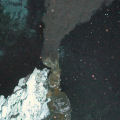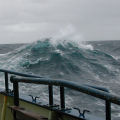Expedition science
|
Why bother investigating the world's deepest undersea volcanic rift? Explore the links below to find out more about where we are going, the science we are doing, and why it matters. |
|
Biology: the unseen depths of the Cayman Trough contain an important missing piece of a global 'jigsaw puzzle' of marine life. Finding out what lives there boosts our understanding of the biodiversity of our planet's largest habitat - the deep ocean. | |
|
Chemistry: the deep-sea vents at the bottom of the Cayman Trough offer us a window on hidden chemical reactions taking place deep in the Earth's crust, which are vital cogs in global cycles of several elements and ultimately control the saltiness of the seas. | |
|
Geology: studying the world's deepest volcanic rift gives us an insight into the fundamental geological processes that shape our world, by investigating undersea volcanoes whose eruptions create the titanic plates of the Earth's crust. | |
|
Physics: revealing the previously unknown deep ocean circulation of the Cayman Trough improves our overall understanding of how ocean currents transport heat and life around our planet, and how that circulation may change over time. |
Technology
Take a tour of our research ship and our undersea vehicles, sensors and systems for exploring the ocean floor.
What are we using?
The Cayman Trough |
The Cayman Trough is a three-mile deep rift in the seafloor of the Caribbean, running east-west between Cuba and Jamaica. We're exploring a chain of undersea volcanoes that run north-south across that rift, just south of Grand Cayman. Check out the area by clicking, dragging and mouse-wheel scrolling in the Google Earth map below. The overlay image shows the best available map of the seafloor of the area before our expedition started. The dark blue areas on the overlay map are deeper than 5500 metres (3.44 miles). The red areas are shallower than 3500 metres (2.19 miles). The overlay image is approximately 100 km (~60 miles) long by 50 km (~30 miles) wide. And somewhere in that area are the world's deepest undersea volcanic vents. |






